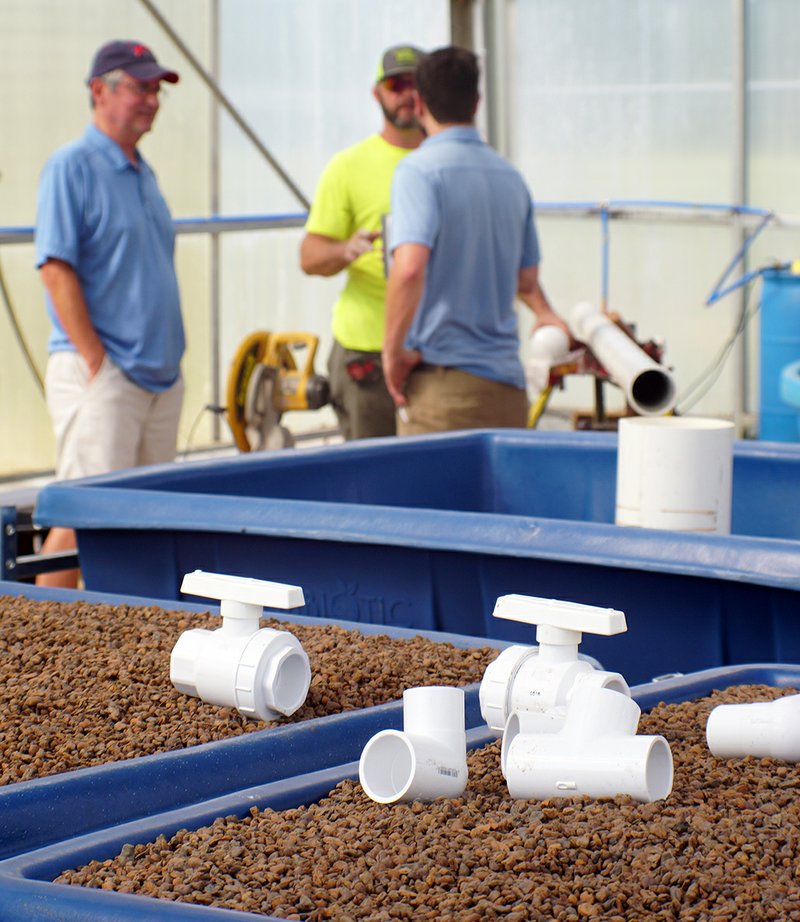GENTRY — Students enrolled in Gentry School District’s agriculture classes and members of the Gentry FFA will soon have opportunity to learn, hands-on, a unique and growing-in-use closed-system farming method called aquaponics. The system hardware was being installed Thursday morning in the high school’s greenhouse by Symbiotic Aquaponic, a company which sells and installs the system.
Growing beds, fish tanks and a water system which included a reservoir and filtration system, along with plastic pipes and valves, were being installed Thursday by Kaben Smallwood, CEO of Symbiotic Aquaponic, and his staff. Students, teachers and administrators were stopping in to observe the process.
Once the system is installed, students will do the planting and monitor the system, said Smallwood. They will also harvest the plants and the fish, he said. According to Smallwood, fruits and vegetables grown in the system can be given away or used in the school's salad bar. The fish, too — in this case, catfish supplied from a local fish hatchery — can be harvested and filleted for food uses.
Wendy Jackson, newly-hired agriculture teacher at Gentry High School, said she is planning to fill the greenhouse with plants. She said spring plants can be started in the aquaponic system, where they will grow quickly, and then transferred to soil so they can be sold as an FFA fundraiser in the spring.
Jeremy Mabry, agriculture teacher at the high school and also an FFA sponsor, was watching with interest as the new system was being installed. He anticipated the installation would be complete by the end of the day on Thursday.
“Aquaponics is the agricultural practice of growing plants and fish in a closed, self-sustaining ecosystem,” the Symbiotic Aquaponic website states. “True aquaponics recycles water within a closed system which, by many estimates, reduces water consumption by approximately 99 percent.”
The website explains that “this means … a tomato grown in an aquaponic system requires 1 percent of the watering required by a tomato grown with traditional farming … because an aquaponic system is more efficient” and doesn’t lose water “to run-off, evaporation and soil absorption.”
The site explains that “aquaponics is a combination of both hydroponic and aquaculture methods.” Hydroponic agriculture grows plants in water, without soil; and aquaculture raises fish in a closed-tank system.
According to the website, “Aquaponic agriculture combines the best of both worlds and leaves behind the unwanted parts. In an aquaponic system, fish waste in the water is cycled into grow beds where seeds or plants are growing. This fish wastewater provides the essential nutrients for plant growth and reduces the need for added chemical nutrients. In turn, the plants essentially clean the waste from the water and return it back to the system where it is re-used and recycled efficiently.
“Aquaponics relies upon microbiological processes to foster the relationship between plants and fish ... Ammonia is released by the fish waste. While high levels of ammonia would normally kill fish in an aquaponic system, this ammonia is converted into nitrites by naturally occurring bacteria that develop in the aquaponic system … The nitrates that result from this conversion process are then absorbed by the plants, which provide all the necessary nutrients for the plants to grow. The result of this natural process is clean water that provides a safe environment for the fish,” the Symbiotic Aquaponic website states.
Once the system is installed and operating, it takes several months of close monitoring before a balance is achieved which supports both sides of the system.
More information on the system and aquaponics is available at the Symbiotic Aquaponic website: www.symbioticaquaponic.com.

